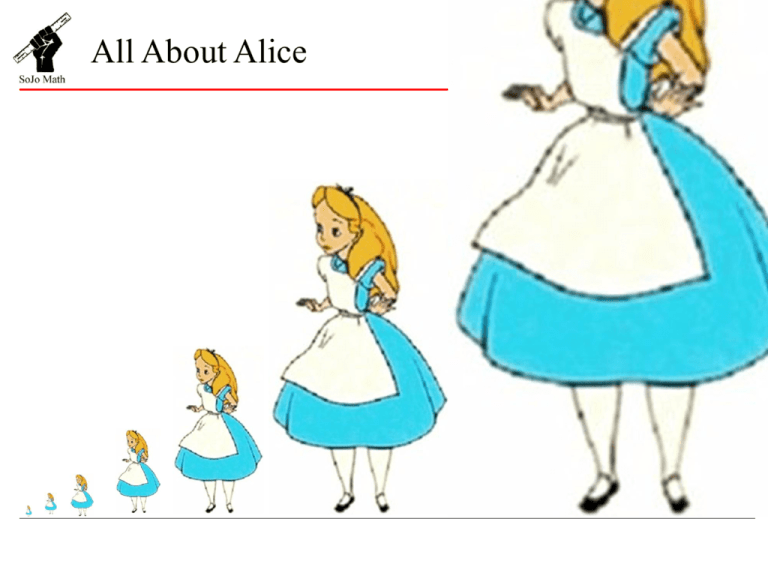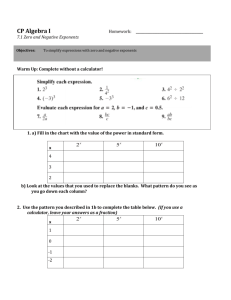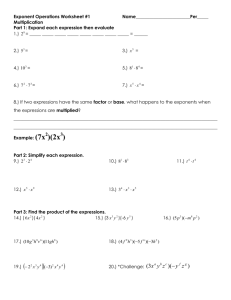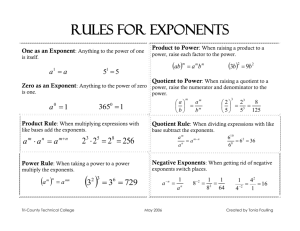simplify
advertisement

All About Alice All About Alice • In math, we love a good shortcut… • If there are 20 students in a class and each student has $5, how much do the students have in total? 5 + 5 + 5 + … + 5 = 5·20 = 100 …multiplication is just a shortcut for repeated addition. • If Alice eats 7 ounces of cake, how many times bigger will she grow? 2·2·2·2·2·2· = 27 = 128 times bigger 2 …exponents are a shortcut for repeated multiplication. All About Alice • The general form of an exponential function is y a bx new amount current amount number of growth factors that initial amount is multiplied by (exponent) growth factor (base) If Alice is 5 feet tall and eats 3 ounces of cake… new height = 5·23 = 5·8 = 40 feet tall If Alice is 12 feet tall and drinks 7 ounces of potion… new height = 12·(½)5 = 12·0.03125 = 0.375 feet tall All About Alice • In A Wonderland Lost, we found that the area of the forest, which is decreasing by 10% every year, could be calculated using the exponential function f ( y ) 1,200,000 (0.90) y because f ( y ) 1,200,000 (0.90) (0.90) ... (0.90) after 1 year after 2 years after y years We used 0.90 as our base value because the new rainforest area is 100% –10% = 90% of the previous area. All About Alice • What if new laws and regulations were introduced so that the area of the rainforest, currently 500,000 square miles, will increase by 2% every year? What exponential function could we use to calculate the area of the forest after y years of growth? f ( y ) 500,000 (1.02) y The base value is 1.02 because the new rainforest area is 100% + 2% = 102% of the previous area. Inflation, Depreciation, and Alice All About Alice • In general… If the current amount is decreased by some %, then we can find the base value of our exponential function by… If the current amount is increased by some %, then we can find the base value of our exponential function by… Simplifying Expressions with Exponents • Simplify 2 7 a ( x y) 3 3 3 3 4x y2 5 3 3x y 6 y2 a b 2 a 2b 2 3 2 Simplifying Expressions with Exponents • Additive Law of Exponents When two exponential expressions with the same base are multiplied, the following property holds: bx · by = For example, 54 · 53 bx+y = (5·5·5·5)·(5·5·5 = 5·5·5·5·5·5· = 57 ) 4 5 3 5 5 Simplifying Expressions with Exponents • Additive Law of Exponents When two exponential expressions with the same base are multiplied, the following property holds: bx · by = For example, x7 · x5 bx+y = (x·x·x·x·x·x·x)·(x·x·x·x·x ) x7 x5 = x·x·x·x·x·x·x·x·x·x·x·x= x12 Simplifying Expressions with Exponents • Simplify h h 3 5 ( x 2 )(2 x5 ) (5 x y )( 2 xy ) 2 3 2 7 a(a 2b)( ab 4 c) negative sign Simplifying Expressions with Exponents • On your own, simplify each of the following expressions. Then, check with a partner to see how you did. (2a 5 )( 4a 2 ) ( xy )(3x y ) 5 2 4 (4a 2c 2 )( ab 4c)( 2b3c) Simplifying Expressions with Exponents • Law of Repeated Exponentiation When an exponential expression is raised to a power, the following property holds: y x (b ) = bx·y For example, 3 (x15) = (x15)·(x15)·(x15 = x15+15+15 = x15·3= x45 ) Simplifying Expressions with Exponents • Simplify (x ) 6 3 (2 x 4 ) 2 c (c ) 5 2 7 ( x ) (3xy ) 2 2 2 4 Simplifying Expressions with Exponents • On your own, simplify each of the following expressions. Then, check with a partner to see how you did. (5 y) 3 3 5 2 4 (2a ) ( 3a ) 7 5 8 5 y ( xy) (2 x ) Simplifying Expressions with Exponents • Find the missing value that will make each equation true. ( x n )( x 3 ) ( x 9 ) a(a ) a n 3 13 (b ) (b ) b 4 5 n 3 20 All About Alice • Negative Exponents • We have looked at many examples involving base values and positive exponents. What happens if a base value has a negative exponent? 23 = 22 = 21 = 20 = 2-1 = 2-2 = 2-3 = All About Alice • Negative Exponents One way to think about this is that the negative exponent just tells you that the base is on the wrong side of the fraction line. To take care of a negative exponent, just move the base and (positive) exponent to the other side of the fraction line. x 2 1 3 b 2y 5 (10a) 4 24( 2 x ) 4 All About Alice • Negative Exponents When the base and exponent move, you must cancel out any common factors in order for the expression to be simplified. 5 x 2 x 8 Does the additive law of exponents still work for expressions with negative exponents? All About Alice • Negative Exponents The law of repeated exponentiation (multiplying powers) is also true for expressions with negative exponents. 5 2 (x ) (b 2 ) 3 ( y 4 ) 2 All About Alice • Negative Exponents Simplify 2 7 3 1 (3a 4b 9 ) (8 x )( x ) (2 x 2 y 4 ) 3 (12 x 9 y 2 ) All About Alice • Negative Exponents There are also cases where the exponent expression is a fraction with numbers and variables in both the numerator and denominator 3 4x x 4 9a 4 6a All About Alice • Negative Exponents Things can get complicated… 3 x y 2 4 x y 8a 5 b 2 3 (2a) b 3 x y 4 5 x y 6 2 All About Alice • Negative Exponents If the entire fraction is raised to a negative exponent, then the numerator and denominator switch places, and the negative exponent becomes positive. x 3 y 2 3 y 2 x 3 3 When the numerator and denominator of a fraction are switched, the resulting fraction is called the reciprocal. All About Alice • Find the missing value that will make each equation true. ( x 8 )( x n ) x 3 4 2 (a ) n a y 10 y n 1 3 a 3 y 6 All About Alice • In A Wonderland Lost, we found that the area of the forest, which is decreasing by 10% every year, could be calculated using the exponential function f ( y ) 1,200,000 (0.90) y The base value is 0.90 because the new rainforest area is 100% – 10% = 90% of the previous area.





